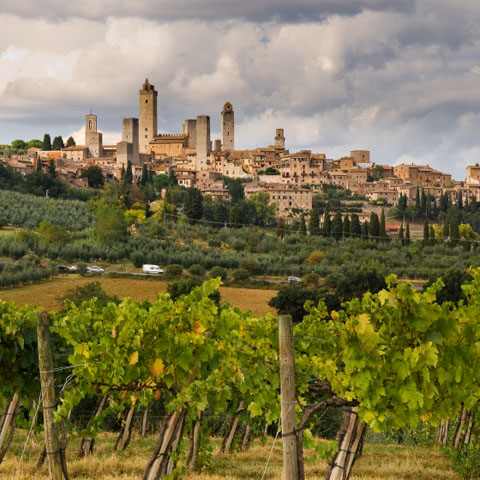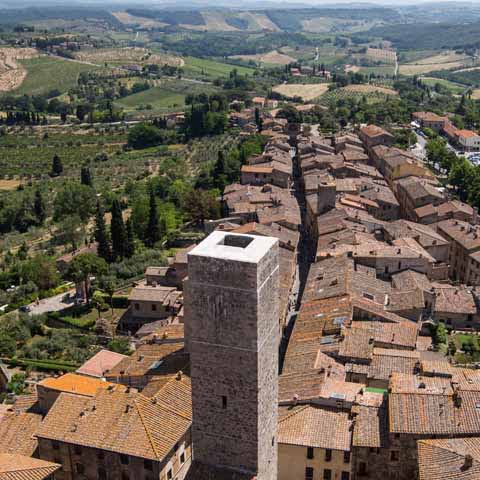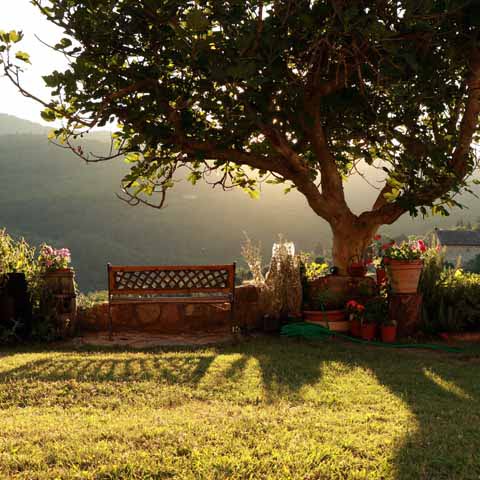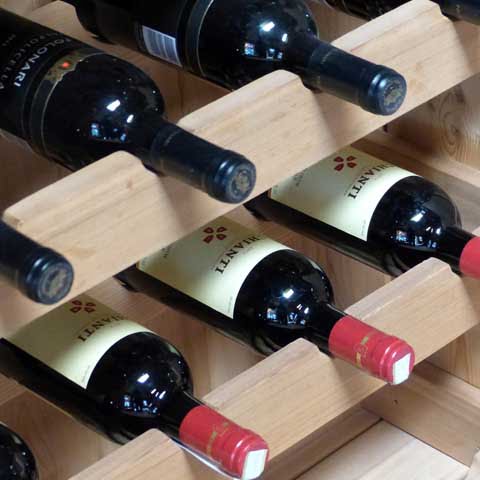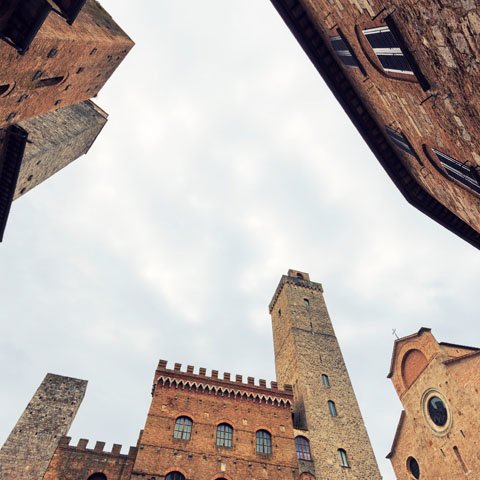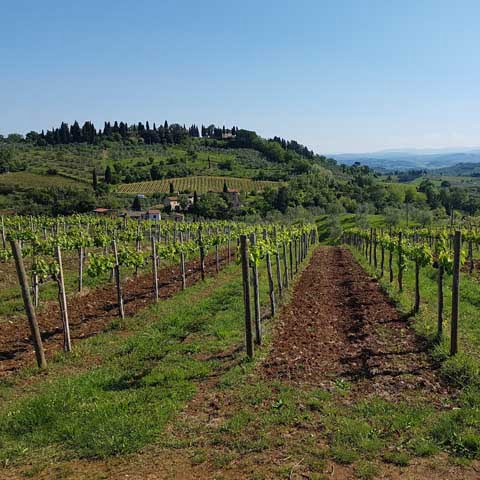The Tuscan town of San Gimignano is a destination known for its hilly landscape and skyline of medieval towers, yet there is much more cultural depth to explore. Once the location of a small Etruscan village, the land later became a popular stop for Catholic pilgrims heading to the Vatican and Rome – providing a much-needed boost to the area’s development and trade market. Despite hardship and the loss of approximately 75% of its population as a result of the Black Death in 1348, the city of San Gimignano has since carried on with its well-preserved medieval ambiance. The historic feel and cultural sights have contributed to the growing presence of tourists hoping to take in all the area has to offer.
San Gimignano is well known for its numerous towers that stand throughout the town – hence its nicknames “Town of Fine Towers” and “Medieval Manhattan.” Travelers can explore the tall structures that were erected as a result of tense family rivalries. In the early 1200s, the Guelph and Ghibelline factions were at odds for nearly two centuries. Drama ensued as families loyal to each faction built tower house after tower house, each taller than the last, to prove their status to one another. Seventy-two towers were constructed as a result. Luckily, the local government stepped in to limit the height to that of the Palazzo Comunale. While they suffered from neglect, the governor ordered their restoration in 1674 – ensuring the fourteen remaining towers could be enjoyed for years to come.
The renowned towers are a large part of what makes San Gimignano unique. The town is home to other numerous artistic and architectural masterpieces – representing human creativity and cultural traditions. The winding cobblestone roads along with two parallel defensive walls that continue to encircle the city are representative of medieval times. These aspects are what earned the city the privileged recognition of being added to the list of UNESCO World Heritage Sites in 1990.
ART IN SAN GIMIGNANO
As with many historic Italian cities, San Gimignano offers visitors must-see artwork from one building to the next. From the stunning frescoes found on the walls of the thirteenth century Church of Sant’Agostino to the variety of art mediums at the Museum of Sacred Art – the small town has its own unique art scene.
Also known as the Duomo of San Gimignano, the Collegiate Church of Santa Maria Assunta is at the top of the list since it is full of extensive frescoes and paintings. Roughly a century after its consecration in 1148, artists were brought in to liven up the cathedral’s interior. Scenes out of the Old Testament by Bartolo di Fredi and the New Testament by Lippo Memmi run alongside the aisle. Frescos portraying the martyrdom of Saint Sebastian by Benozzo Gozzoli and the Last Judgement by Taddeo di Bartolo can be found in the nave. Numerous other frescos by artists such as Domenico Ghirlandaio, wooden sculptures by Jacopo della Quercia, and the altar in the Chapel of Santa Fina add to the complete art experience.
Another important church is the Church of San Lorenzo in Ponte, which was constructed during the thirteenth century. The Romanesque church is characterized by a simple brick façade and a small bell tower. Inside, travelers can marvel at another series of beautiful frescoes that depict scenes from the life of St. Benedict. Also in the church is a fresco featuring Christ with the Apostles and Virgin Mary by Cenni di Francesco di Ser Cenni.
Museums found throughout San Gimignano provide a different setting for displaying unique works of art that have been preserved. These include the town’s civic museums: Palazzo Comunale, the Gallery of Modern and Contemporary Art, and the Archaeological Museum.
Palazzo Comunale, which is San Gimignano’s town hall, is located in Piazza del Duomo. The inner courtyard features stunning frescoes depicting the coat of arms of the most important historic citizens of the town. The inner reception hall called Sala di Dante is renowned for the fresco Maestà by Lippo Memmi. The building also features an art gallery with works by artists such as Benozzo Gozzoli, Filippino Lippi, Coppo di Marcovaldo, Pinturicchio, and more. From Palazzo Comunale, intrepid travelers can choose to make the climb to the top of San Gimignano’s tallest tower, Torre Grossa.
Located in a former conservatory, the Santa Chiara Museum Complex extends over two floors. On the first floor, travelers will find the Herbarium of Santa Fina (a historic pharmacy) and the Archeological Museum, which showcases local Etruscan and Roman artifacts, such as Etruscan funerary urns. The second floor hosts the Gallery of Modern and Contemporary Art “Raffaele De Grada.” Inside, art lovers can admire works by twentieth century painters such as Renato Guttuso, Ugo Nespolo, Niccolò Cannicci, and the museum’s namesake. In addition to the permanent collection, this museum also serves as San Gimignano’s largest venue for temporary art exhibitions.
While San Gimignano’s historic art is quite breathtaking, the town is also filled with vibrant contemporary art and unique installations. One example is the 1994 project called Affinità. Cinque artisti per San Gimignano, which consists of five works of art by five different artists installed in areas around town to promote a link between the town’s medieval and contemporary art. In addition to collaborative projects, several other contemporary artists have left their mark on San Gimignano, such as Silvia Beghè and Maurizio Masini.
ARCHITECTURE IN SAN GIMIGNANO
Throughout the Italian town of San Gimignano, visitors can take in the Gothic and Romanesque architecture, alongside structures with characteristic curved archways. Unique to the area, arched entries are set back and doorways consist of a semi-rounded arch with a lower arch placed just below. The beauty is in the details of each structure.
The main highlight of San Gimignano’s architecture are the fourteen remaining medieval towers and ruins of many others. Not only do the towers give the city a visual presence from miles away – the tallest being 177 feet tall – they represented economic power and elite craftsmanship of rival families. The towers were constructed from a variety of materials depending upon the time and had different purposes. The initial towers were simple and built of wood and soil, while those built later included brick with more detail and style. Many acted as homes complete with living quarters and workshops. After taking in the exterior height and construction, visitors can explore their interiors – opting to climb the 200-foot City Hall or staying the night in a tower is an option for those looking for the full experience.
At the center of San Gimignano are four separate piazze, or squares: Piazza Duomo, Piazza della Cisterna, Piazza Pecori, and Piazza Sant’Agostino.
Each square has its own architectural highlights to offer visitors. The Piazza Duomo is the site of the Duomo, or Collegiate Church, which represents a Tuscan Renaissance style, while the Church of Sant’Agostino can be found in the square of the same name – Piazza Sant’Agostino. The Collegiate Church was erected during the 12th century while the latter was built during the 13th century. Also in Piazza Sant’Agostino is the Church of San Pietro, which is among the oldest churches in town.
Piazza della Cisterna is considered to be one of the most beautiful squares in San Gimignano. At the center of the square is a large well that has contributed to the name of the square. Piazza della Cisterna is lined with historic palaces including Palazzo Tortoli, Palazzo Ridolfi, Palazzo Ardinghelli, and Palazzo Pellari.
Nearby Piazza Pecori features an elegant baptismal font decorated with images depicting the Baptism of Jesus. The square is named in honor of nineteenth century local Luigi Pecori who chronicled the first collected history of San Gimignano. The square also features the Loggia of the Annunciation with a fresco of the Annunciation by Ghirlandaio.
In addition to these four squares, Piazza delle Erbe is also worth a visit. Adjacent to Piazza Duomo, Piazza delle Erbe most likely received its name from the local market it hosts. Most unusually, the square is shaped like a triangle. Two of San Gimginano’s famous medieval towers, which were constructed by the Salvucci family, are located in the square.
Though not the tallest, one of San Gimginano’s most beautiful towers, Torre Chigi, is located in Piazza Duomo. Constructed in 1280, the tower once belonged to the Useppi family and then the Chigi family. The tower, which has an elegantly decorated interior, offers scenic views of the area and is surrounded by San Gimignano’s characteristic medieval buildings.
Originally built as a Florentine fortress during the fourteenth century, the Rocca of Montestaffoli’s history and architecture are equally interesting. After serving as a fortress, the structure became a Dominican convent. Once adorned with turrets on each corner as well as a front gate and drawbridge, today just one of the remaining turrets is accessible to travelers. From the turret, it is possible to admire stunning views of the surrounding area.
Distinct from San Gimignano’s other famous medieval churches, the Church of Madonna dei Lumi is an excellent example of local Baroque architecture. Constructed in the seventeenth century, the church features an ancient icon of the Virgin Mary. During the twentieth century, the church was restructured and given the appearance it has today.
Another architecturally distinct structure is the Church of San Francesco, which is renowned for its stunning white façade contrasted by brick buildings on either side. The façade, characterized by dark stripes, is reminiscent of the architectural style in Pisa. Though most of the church was demolished during the eighteenth century, thankfully the beautiful façade remains,
One building that is an integral part of San Gimignano’s local culture is Santa Fina’s House. During her brief life, Santa Fina suffered from a debilitating illness and spent most of her life in her home, which is now a chapel. The local saint is highly venerated in San Gimignano and each year on Santa Fina’s Feast Day (March 12) it is possible to visit her home.
LITERATURE IN SAN GIMIGNANO
While known for its architecture and artistry, San Gimignano is culturally balanced, with creativity coming in numerous forms.
The Tuscan town was the birthplace of Folgóre da San Gimignano, a poet born in 1270 and known for his sonnets. Among his most revered pieces are the Corone – describing the days of the weeks and months of the year. The sites of this scenic city have been featured in novels including John Grisham’s The Broker, and San Gimignano was also the inspiration for the setting of Where Angels Fear to Tread by E.M Forster.
Also worth noting is the town’s Public Library, which is located in the Conservatory of Santa Chiara. This remarkable place is home to more than 70,000 volumes from the sixteenth to the nineteenth centuries and more than 3,500 files that date as far back as the year 1250.
MUSIC
While the music scene of San Gimignano may not compare to that of Milan or Venice, this small medieval town has its own music entertainment to enjoy. In particular, San Gimignano Musica hosts classical music concerts that appeal to both the music enthusiast and the casual listener. The performances typically consist of a mixture of genres including Italian baroque, sacred music, and opera sung by both local Italians as well as musicians from around the world. From Mozart and Verdi to Monteverdi and Bach, travelers can relax and enjoy an Italian music experience.
From whimsical medieval buildings to stunning frescoes and intricate sculptures, San Gimignano is home to a wealth of cultural treasures. As one of the most revered small towns in the country, San Gimignano is the perfect place to experience the best of Italy.
CINEMA
The towers and medieval atmosphere throughout San Gimignano have brought several film directors to the area over the decades. The city has served as the backdrop for a variety of films such as: The Living Dead Man (1925), Prince of Foxes (1949), La ragazza del Palio (1957), Brother Sun, Sister Moon (1972), Il prato (1979), and Tea with Mussolini (1999).
SCIENCE
For a unique experience, San Gimignano is home to the Ornithological Museum – centered around exactly that – ornithology. Visitors can learn about the scientific study of birds by viewing ornithology fanatic, Marianna Panciatichi Ximenes d’Aragona Paolucci’s historical collection. Made up of about 370 specimens, her naturalistic collection was accumulated between 1866 and 1911 and later donated to the town in 1927.
Don't just see Italy, live it.
Your dream trip to Italy has never been closer
No more endlessly scrolling travel sites. Our travel experts will craft the perfect, one-of-a-kind trip just for you.

300+
DESTINATIONS
We offer more Italian destinations than any travel site. Do and see more with Trips 2 Italy.
1 (of a kind)
ITINERARIES
Because your dream trip to Italy should be designed for you, not for the masses.
100%
PEACE OF MIND
From flights and accommodations, to food and activities - we take care of every detail.
